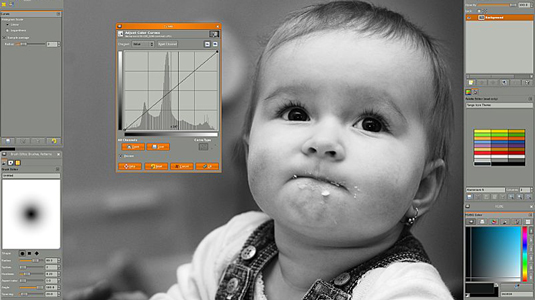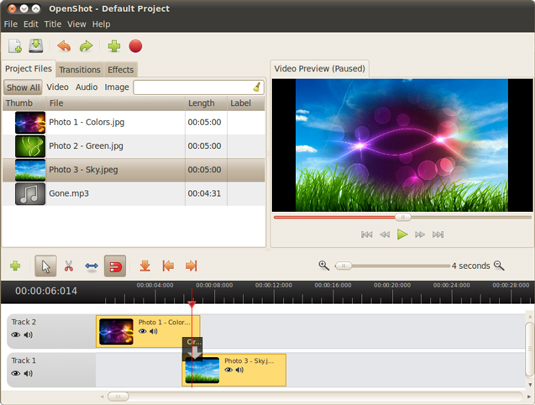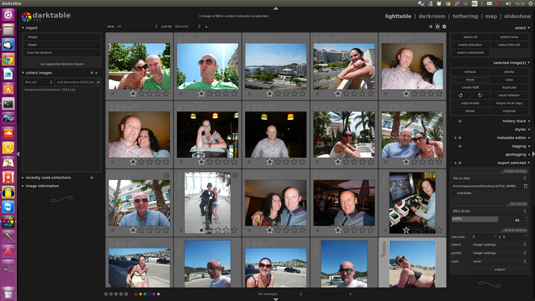The free alternative to Adobe's Creative Cloud
Want a suite of creative tools at no cost whatsoever? Ubuntu Studio is entirely free and specifically aimed at artists and designers.
For all of us that do design, graphics, web, multimedia and audio work, Adobe's Creative Cloud has been the cornerstone of our lives. It's played an overwhelming part in creating this market, and owned it ever since.
In most of the areas Adobe plays in, it has no significant competition to speak of. And serious credit goes to them for fiercely pushing the envelope of what their tools will do, even without significant market competition. But no matter how benevolent Adobe's dictatorship may be, we all enjoy some options.
There's a huge group of wonderful content creation tools that have been available for years from the open source community. I've always been amazed how few of our peers know about what it is, what it has to offer, or that it even exists.
I got turned on to the open source community about 14 years ago. At the time most of the projects were rather young, but already doing fantastic things. The operating system known as Linux was the most well known project, of course. And while it never took over the world the way some of us anticipated it would... Well, maybe it has, when you stop to realize that both Mac OS X and Android are based on open source Linux/Unix code.
Ubuntu is just one of many flavors of Linux out there, and has emerged as the most popular desktop Linux distribution/project. Ubuntu Studio is another derivative project, which we will discuss in a minute.
Productivity packages

Beyond the operating systems, other projects popped up with goals of developing all kinds of software applications and tools. Many of them mimic commercially available software packages, and often make for excellent replacement options. Most have been in development for quite a few years at this point, and have evolved into powerful and reliable tools.
One example that I hope you have at least heard of is GIMP, which is an open source alternative to Adobe Photoshop (or other pixel editors). It's a powerful and hugely capable application that has been made to run on Linux, Mac OSX and Windows systems.
Daily design news, reviews, how-tos and more, as picked by the editors.
So you can go up to GIMP right now, download the installer for your operating system and have it running in 10 minutes. Even if you use Photoshop, you may find things you like about GIMP, or even a couple of things it does better!

But there's more. Have you ever heard of Inkscape? Well, that wonderful little program is the open source alternative to commercial Bezier illustration tools (yeah, we can say it, Illustrator). Let's do one more, okay? Do you know Blender? It's a super-powerful 3D application that in many ways rivals top commercial options.
Realize that I could keep going on, program after program. Now you should know that these open source programs are not trying or intending to be carbon copies of Adobe's or any other commercial company's product.
But like all programs, they are all influenced by one another. As one person said about GIMP, "Feature-wise it's a lot like running a version of Photoshop from a few years ago." Really, what's wrong with that?

If you must have certain features only available in commercial applications, then certain open source packages may not be for you. But keep in mind that most offer the ability to read and write their files to industry standards file formats.
So GIMP will read and write Photoshop format (in addition to JPG, TIF, etc.). Inkscape supports SVG, EPS and PDF, and Blender has a wide range of 3d standard exports. So integration with your other applications, and with other team members using commercial software is very doable.
Pulling it all together
You want your computer life as simple as possible and get down to creating. The project developers at Ubuntu Studio get that too. An off-shoot project from the regular Ubuntu team, Studio's main goal is to create a distribution designed for artists that already includes all the tools you might need in your daily work of making content.
So instead of having to download and install Ubuntu, and then each and every productivity software package one at a time, Studio does it all for you. Its single 2.7Gb download includes a long list of tools, all of which get installed at the same time you install Ubuntu itself. Reboot after the install, and you are presented with a kicking content creation workstation, ready to get to work. You have never had it this easy on Mac or Windows! Or as affordable.
So what software is actually included? Full lists can be seen at the project's page and at the Wikipedia page, but here are a few highlights:
Graphics/publishing

- MyPaint: For digital painters. It lets you focus on the art instead of the program. You work on your canvas with minimum distractions, bringing up the interface only when you need it. Think of Corel's Painter.
- Scribus: A professional page layout program for Mac OS X, Windows, Linux, with a combination of press-ready output and new approaches to page design. It features, color separations, CMYK and spot colors, ICC color management, PDF creation, vector tools, an active community, great documentation and has been translated into 25 languages.
- InkScape: As mentioned, this program is akin to Adobe's Illustrator or other bezier based art creations software. It is powerful with the tools to make top-notch quality commercial art.
- GIMP: Not only is GIMP a popular alternative with its own magazine, it even has derivative projects that try to make it more Photoshop-like, for those old dogs that can't learn something new. Gimpshop is the most popular.
Video production

Video has been a bit of a weak link on Linux and the open community. But in the latest release, Studio now includes:
- Openshot: This is an easy to use video editing application. Use it to create DVDs, YouTube clips and a range of other content output. Its feature list includes unlimited layers, compositing, titling, 3D animated titles, and more.
- DVDStyler: Use DVDStyler to create custom, professional looking DVDs.
- VLC Media Player with FFMPEG Codecs: Debatably the best player on any platform, VLC is a very capable and robust program that does far more than it would seem at first look. With the codec package FFMpeg, it can play almost anything you can throw at it.
- (Not included in this release of Studio, but it would be worth looking into LightWorks video editor, which is an increasingly popular and powerful option, and can be added to your Ubuntu Studio.)
Photography

- Darktable: A photography workflow application and RAW developer. A virtual light-table and darkroom for photographers. It manages your digital negatives in a database. Much like Adobe's Lightroom or Apple's Aperture.
Multimedia

- Ardour: A very popular and powerful Digital Audio Workstation (DAW), suitable for recording, mixing and mastering. It includes a long list of pro features like non-destructive, non-linear editing with unlimited undos, anything-to-anywhere signal routing, and video synced playback controls.
- SYNFIG: A 2D vector graphics and timeline-based animation program , with a sample animation , and a related clip from a dedicated user of this software .
- Blender 3D: Its feature-set rival the heavyweight apps. It has a photo-realistic rendering, powerful character animation tools, camera tracking, and video editing! Check out the Blender Open Movies.
(Note that Studio contains a large list of audio and music creation tools, far too long to list here.)
Installing Ubuntu Studio
I have not installed Studio for a year or two, so my experience is a tad dated. But I can tell you it was a surprisingly easy process.
- Download the installer
- Burn it to a DVD (or put it on a thumb drive)
- Boot the destination computer with the DVD in the drive, and follow the prompts for installing.
That's it. On a basic install onto an empty hard drive, it's easy. The next time you reboot, you have a new workstation. You even have the option to run it in a test mode from the DVD, and not install it. This is probably a good idea, and is a safer bet if you don't have an empty hard drive to install on just yet.
The video above steps you through installation: but there are written and other videos to be had as well. It gets more complex if you wish to dual boot Ubuntu OS alongside Windows. These videos speak to that, for Windows 7 and Windows 8.
Note that some viewers said they had issues doing a dual-boot system, so care needs to be taken. Dual boots can be made much safer if you do it on two physically different hard drives, rather than just two partitions on the same hard drive.
Ubuntu Studio forums has over 6,500 threads, most with multiple replies. So while it doesn't compete with the Adobe Forums for web hot-spot, there is no question this is a active forum with an engaged community. With many people that can answer questions. There's even a magazine dedicated to content creators working in the open source space, Libre Graphics World.
Alternatives
Stepping into any new application or operating system is a bit like going to a foreign country. They have houses, cars, streets and everything you have at home. But it's all just a little bit different and you have to get used to it.
As amazing as Ubuntu OS is, and all the apps Studio includes, the differences may all be a bit much for some people. And while a Linux system is hardly as rare as it used to be, you will certainly have a harder time getting tech support from your local superstore's computer department, compared with walking in with a Mac or Windows issue.
The truth is, you can get most, if not all, of the software that Studio offers without actually leaving your existing operating system. These days, most of the applications that are included in Ubuntu Studio are compiled for Mac and Windows, as well as Linux. So go download some of them and try them out!
Not sure what software to try? There are at least three websites dedicated to telling you the open source alternatives to your commercial software. They are osalt, Open Source Alternative and alternativeTo.
Words: Lance Evans
Lance Evans is creative director of Graphlink Media.
Like this? Read these!
- Download the best free fonts
- Our favourite web fonts – and they don't cost a penny
- Download free textures: high resolution and ready to use now
- Free Photoshop brushes every creative must have

The Creative Bloq team is made up of a group of art and design enthusiasts, and has changed and evolved since Creative Bloq began back in 2012. The current website team consists of eight full-time members of staff: Editor Georgia Coggan, Deputy Editor Rosie Hilder, Ecommerce Editor Beren Neale, Senior News Editor Daniel Piper, Editor, Digital Art and 3D Ian Dean, Tech Reviews Editor Erlingur Einarsson, Ecommerce Writer Beth Nicholls and Staff Writer Natalie Fear, as well as a roster of freelancers from around the world. The ImagineFX magazine team also pitch in, ensuring that content from leading digital art publication ImagineFX is represented on Creative Bloq.
